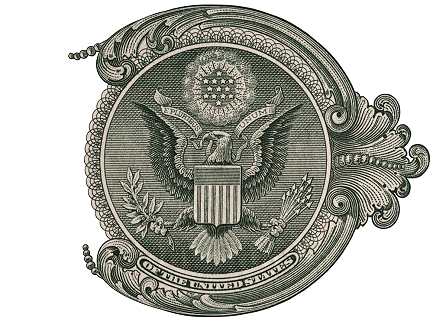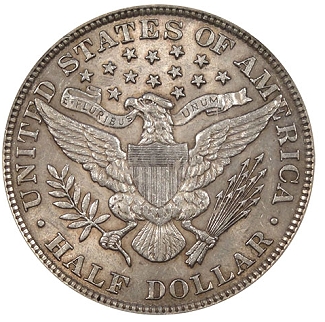By Dan Duncan – Retired, Pinnacle Rarities ……
Many of the coins we collect are graced with images of the bald eagle, our national bird. Most of these are portrayals of the regal bird as depicted on the Great Seal of the United States, with the adaptation of this heraldic eagle design and its use in various forms on much of classic numismatics.
 The Continental Congress recognized the need for a national seal immediately. Upon the adaption of the Declaration of Independence in July of 1776, it formed a committee consisting of Thomas Jefferson, John J. Adams, and Benjamin Franklin. The three founding fathers quickly turned to local artist Pierre Eugene du Simitiere who produced designs (without the eagle) which were submitted in August of 1776. These were allegedly rejected as too complicated and the project was tabled.
The Continental Congress recognized the need for a national seal immediately. Upon the adaption of the Declaration of Independence in July of 1776, it formed a committee consisting of Thomas Jefferson, John J. Adams, and Benjamin Franklin. The three founding fathers quickly turned to local artist Pierre Eugene du Simitiere who produced designs (without the eagle) which were submitted in August of 1776. These were allegedly rejected as too complicated and the project was tabled.
The seal wasn’t completed until six years later and after two additional committees had taken up the charge. Both produced ideas for seals which were rejected. The second committee had turned to Francis Hopkins, designer of the nation’s flag and the seal for the State of New Jeresy. His design incorporated that of the earlier committee, but also was heavily influenced by the flag. This too was rejected. A third committee was formed in early 1782 and their initial design created by Lawyer William Barton was also rejected.
After which all the work from the three committees was turned over to the Secretary of Congress, Charles Thomson. He simplified the designs and passed it through Congress without an official drawing. Using this framework he envisioned what is now the Great Seal of the United States. By summer of 1782, an undetermined engraver (possibly Robert Scot) produced a brass die for use, featuring a Heraldic Eagle. Over the decades that follow, this design becomes one of the most dominate motifs in American numismatics.
 It was the late 18th century when Robert Scot created the reverse designs for the new gold coinage. He featured an eagle on his reverses. But after some criticisms, he modified his original eagle. Scot’s newer design thickened the neck and hid the legs of the bird with the shield. Some suggest this new stronger look was not Scot’s original work, but history gives Scot the credit. This eagle resembled the Great Seal as adopted a decade earlier. Over the coming century and across various denominations the overall design morphed, losing the clouds and with various depictions of stars and other elements above the eagle. Through all this, the symbolism has stays basically the same.
It was the late 18th century when Robert Scot created the reverse designs for the new gold coinage. He featured an eagle on his reverses. But after some criticisms, he modified his original eagle. Scot’s newer design thickened the neck and hid the legs of the bird with the shield. Some suggest this new stronger look was not Scot’s original work, but history gives Scot the credit. This eagle resembled the Great Seal as adopted a decade earlier. Over the coming century and across various denominations the overall design morphed, losing the clouds and with various depictions of stars and other elements above the eagle. Through all this, the symbolism has stays basically the same.
The eagle has long been seen as a symbol of power. The bird is considered the king of the skies, and is a representation of both strength and courage. The keen eye and open wings are symbols of readiness and clear sight. In the talons are both arrows and an olive branch, signifying both war and peace. The shield in front of the eagle shows it to be a protector, adorned with 13 stripes for the original states (colored on the seal red and white) and the top of the shield (colored blue) represents the Congress. The nation’s motto placed on the ribbon is used in various forms and omitted on some. The clouds and stars above the eagle are eventually removed from later designs, represent a new constellation among the heavens, like the new nation our founding fathers had created.
In the 1830’s, Christian Gobrecht’s early ideas moved away from the motif by using an eagle in flight. The eagle was positioned to show a nation growing and moving up. This was not used in circulating coinage, however, but a Heraldic Eagle featuring a smaller shield was eventually adopted. Gobrecht’s flying eagle did grace the small cent, but was not positioned flying “onward and upward” as on the early Gobrecht dollars.
 In 1878, George Morgan’s dollar removed the shield, but kept the readied eagle with wings spread. And in 1892, his contemporary Charles Barber simply re-imaged the seal’s original design, returning the stars to his reverse of the quarter and half. These designs were replaced between 1907 and 1921 on the various denominations. For these replacement designs, the eagle was still used, but the heraldry was replaced with more artistic representations of our national bird.
In 1878, George Morgan’s dollar removed the shield, but kept the readied eagle with wings spread. And in 1892, his contemporary Charles Barber simply re-imaged the seal’s original design, returning the stars to his reverse of the quarter and half. These designs were replaced between 1907 and 1921 on the various denominations. For these replacement designs, the eagle was still used, but the heraldry was replaced with more artistic representations of our national bird.
Over the last two hundred and twenty plus years, the eagle motif has seen a number of different looks across our nation’s coinage. Many of the early representations feature the heraldic eagle for it intense symbolism and ties to the birth of this great nation. From our founding fathers to our modern coinage, the symbolism still carries weight. And the use of our national bird still shines as a beacon of light and as a symbol of our nation’s might and readiness to defend.
* * *




